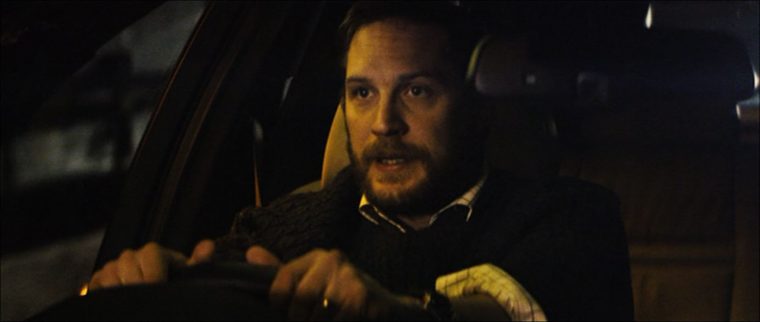
Locke (Tom Hardy) deals with the consequences of his choices from behind the wheel of a BMW X5.
Photo: Shoebox Films
In the follow-up to his directorial debut last year (Hummingbird, starring Jason Statham), Steven Knight writes and directs Locke. This one-man tour-de-force stars iron-jawed Brit Tom Hardy, coming off his career-making success as Bane (The Dark Knight Rises) and Eames (Inception).
It’s a one-actor, one-location performance, and it’s not the first example we’ve seen recently. You know the setup: an up-and-coming actor is worried about being pigeon-holed into summer CGI blockbusters and thus takes on a challenging minimalist drama. You’ll recall Ryan Reynolds being Buried for this; James Franco stuck for 127 Hours; and, Sam Rockwell on the Moon.
Hardy is the latest actor to assert his dramatic acting prowess via one-man-presentation in Locke.
More: How to change your windshield wipers
The Plot
Two paths lie ahead of building site manager Ivan Locke (Tom Hardy): one to his routine function as a beloved husband and trusted concrete foreman; the other to face the mistakes of his past. Being a self-assured perfectionist who subdues his feelings to pursue practical solutions, Locke decides this night to drive to London and, over the course of 90 minutes, try to make things right. However, as much as he tries to stop it, one action still causes a multitude of reactions.
That’s essentially all we can share without spoiling the mystery of Locke as it slowly unfolds. So, for the sake of our overview, we’ll ask a different question: does the film fit the established “road trip” formula?
While unorthodox, it essentially does.
Locke’s journey from the familiar (his work and family) into the unknown (the nighttime highways of the UK) begins in his car and takes him through unfamiliar territory that challenges the life he’s created, as well as his choices. The people and situations he encounters along the way are not done in person but rather over the phone. In the end, he must decide what’s most important to him and follow through with it, re-evaluating his current priorities along the way.
The Vehicle
Tom Hardy takes his life-changing drive in a granite-colored (har har) previous-generation BMW X5 (E70) M-model SUV. While the entire story does take place within the car, it’s hardly ever shown from the outside. Still, many of the X5’s features are central to the action on screen, particularly the hands-free calling.
Locke’s BMW’s Bluetooth integration is central to the film. It allows him to converse with multiple people concurrently and to address multiple situations. It also allows him to distance himself from directly facing his family and his employer, even stopping the conversations when he wants to (something one couldn’t do in person).
When the right-hand-drive vehicle is first entered, other technology aspects are shown, like the wheel adjusting itself. During the drive, the on-board GPS shows that Locke is in the middle of a long highway, heading on a road to new territory. He also uses the rear-view mirror as a reflection into his past and his own thoughts.
In an interview for BMW, director Steven Knight shared that he used to own a BMW X5 himself and chose the vehicle for the film crew’s needs. The car had to “reflect the character’s success” in his occupation but could still drive through construction sites. The BMW X5 was also “spacious, roomier to get three cameras in there.” For the dirty places the BMW has been, like the construction sites, it’s as pristine as Locke tries to keep his life.
All-in-all, it winds up as a smooth bit of “product integration” to see a BMW in action without being the camera’s focus.
Our Locke Review
The one-location premise–this time on wheels–is not as claustrophobic as the approach usually is, but the intimate journey alongside Locke is an uncommon approach to studying the struggles of blue-collar working men.
Tom Hardy’s performance is what makes the film successful. His vocal tones, pensive expressions, and subtle body language are sharp contrasts to the resolution in his dialogue. With that approach, he refrains from overacting.
The script only reveals bits of information in spoonfuls, allowing the viewer to enter into Locke’s world through gradual comprehension. This helps keep the simplistic plot engaging through the entire film. And, the use of the BMW X5 never feels like an advertising gimmick.
Locke’s most substantial flaws are some of the heavy-handed parallels between Locke’s profession and his outlook on life (struggling to establish control in his life without letting one mistake collapse it all), as well as the hesitant conclusion that fails to leave an impact. As with many independent films these days, if you’re not sure how to end it, leave it symbolically open-ended.
For being written in one week and filmed in two, it’s still an impressive minimalist undertaking, even if the ending does feel like a cop out.
Related: Find out who is America’s biggest auto exporter
Aaron is unashamed to be a native Clevelander and the proud driver of a Hyundai Veloster Turbo (which recently replaced his 1995 Saturn SC-2). He gleefully utilizes his background in theater, literature, and communication to dramatically recite his own articles to nearby youth. Mr. Widmar happily resides in Dayton, Ohio with his magnificent wife, Vicki, but is often on the road with her exploring new destinations. Aaron has high aspirations for his writing career but often gets distracted pondering the profound nature of the human condition and forgets what he was writing… See more articles by Aaron.